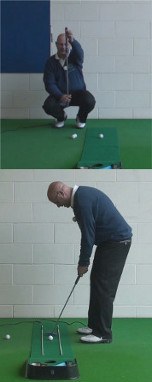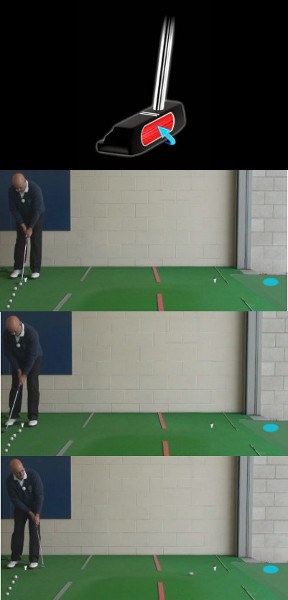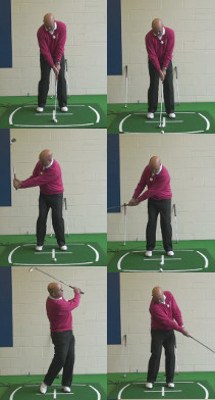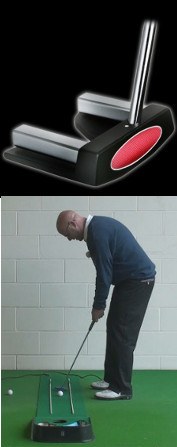
As the senior advances in years, maintaining a sharp short game becomes even more essential as the long shots don't quite fly as far through the air.
Having the ability to get up and down from under 100 yards becomes essential if the senior wishes to maintain their handicap.
Listed below are some top tips and drills working outwards from 3 feet to 50 yards to practice and use during a round to improve your short game, touch and feel.
1. Short Putting Wheel - Place 10 balls in a circle around a hole which features some undulation to ensure some putts with different breaks. Work clockwise around the circle trying to hole as many putts as possible. This drill will help keep the senior golfer sharp on those tricky short putts.
2. Ladder Putting - Place 10 balls two feet apart, stretching in a line away from the hole. The first putt should be two feet in length and the last, 20 feet in length. Work backwards down the line away from the hole trying to hole as many putts as possible. This will help keep the senior golfer holing those crucial putts inside 20 feet.
3. Fringe Putting - With five balls, putt from one side of the putting green to the other attempting to get the ball stopping as near to the opposite fringe as possible. This will help the senior golfer in maintaining touch and feel on long range putts.
4. Spot Chipping - Pick a spot five yards off a green and place a clearly visible tee peg 10 yards on the green. Practice hitting chips on to the green, landing as close to the tee peg as possible. This drill will help the senior golfer consistently judge the length of their chip shots and will improve touch.
5. Bench Chipping - One reason a lot of senior players lose touch around the greens is a breakdown of the left wrist at impact which causes a 'flick' at the ball through impact. A way to keep the left wrist firm and ahead of the ball at impact is to hit a number of low chip and run shots on to a green, imagining a low running bench just before the putting surface. By getting the feeling of chipping shots under the bench, the senior golfer should be able to keep the left wrist firm and gain a more consistent strike around the green.
6. Umbrella Pitching - Place an old umbrella open and pushed into the grass 30 yards away on the practice ground. Practice hitting 20 balls at a time into the open umbrella. This will help the senior golfer fly the ball all the way back to the target, pitching the ball up near the umbrella.
7. Ladder Pitching - Place five targets down the practice range in a line from 10 to 50 yards. Practice hitting a ball to each target from short to long down the range with the same club. This will help the senior judge different distances with the same club improving touch.
Another way to help ensure a senior can maintain their touch around the green is grip pressure. Many golfers, especially when nervous, begin to tighten their grip on the club.
This extra tension in the arms will kill touch and feel. Try to keep your grip pressure to a minimum around the green, keep those hands soft.

How to Best Improve Short Game Touch and Feel
If you are going to become a good golfer, you will need to develop your short game skills. There is no way around that fact, as the short game is simply a crucial part of playing golf. You can't shoot good scores without a well-rounded short game, as each and every hole is going to include at least one short game shot, and probably more (unless you hole out from the fairway – which is rare, to say the least). The average golfer overlooks the short game while working on his or her full swing at every opportunity. It would not be an exaggeration to say that this obsession with the full swing is why the average golfer remains, well, average.
In this article, we are going to provide some advice on how you can effectively improve your touch and feel in the short game. This does not necessarily relate to the way you execute your technique – rather, it relates to your ability to hit the ball the right distance. When someone says that a golfer 'has good touch' on or around the greens, what that person means is that the player is consistently able to hit the ball the right distance. It isn't particularly difficult to get short game shots on line. Rather, it is the distance control that is the big challenge. Develop your touch to a point where you can frequently hit the ball the right distance and your short game will be dramatically improved.
The idea of developing touch in the short game is one which is often overlooked. Many golfers believe you either have good touch or you don't, and nothing can be done to change your natural ability. Nothing could be further from the truth. Sure, there are some players who come to this part of the game more naturally than others, but that doesn't mean you are stuck where you are. With consistent practice and attention to detail, you can certainly improve on your feel with both the putter and your wedges.
In the previous sentence, we mentioned that you will need to practice in order to get better in this area of the game. That might seem like an obvious point, but many golfers fail to practice their short game. The average player arrives at the driving range, hits a bucket of balls, and gets back in the car without even looking at the putting green. If you are serious about low scores, the putting green (and practice chipping area) will become your priority. It is usually the players who frequent these areas that have the lowest scores when all is said and done.
All of the content below is based on a right-handed golfer. If you happen to play left-handed, please take a moment to reverse the directions as necessary.

Finding Your Touch on the Greens
To get started, we are going to talk about developing your touch with the putter. If you are going to consistently make putts – and if you are going to get down in two putts from even the toughest spots around the green – you have to have good touch. The ability to roll the ball the right distance is actually more important than being able to hit your line each time. When your putt goes the right distance, it will leave you close to the hole even if your aim was off slightly. Master your putting touch and this difficult game will suddenly seem quite a bit easier.
Contrary to what you might believe, putting touch is about both long putts and short putts. When you are putting from long distance, you need to get the speed right in order to leave yourself with an easy second putt. From short range, where you will obviously be trying to make your putts, good feel is necessary in order to match up your line with your speed properly. Playing the right amount of break depends completely on how hard you are going to hit the ball, as the ball is going to break more from side to side when hit softly than it will when hit firmly. So, no matter whether you are putting from close in or from far away, having great touch is going to serve you well.
The following list contains a few basic ideas on how you can improve your feel on the greens.
- Hit plenty of long putts. Many golfers fail to practice their putting at all, except for maybe hitting a few putts just before they walk to the tee to start a round. Those golfers who do spend some time practicing on the greens tend to practice in the wrong way. Many of these players get stuck close to a hole, just knocking in three-footer after three-footer for ten or fifteen minutes. While it is certainly worthwhile to practice your short putting, doing so isn't going to do much for your feel. For that, you will want to hit plenty of longer putts. Take some time to roll putts back and forth across the putting green, finding a path which is not going to get in the way of another golfer. Each long putt you hit is going to help you further develop your ability to control speed. Don't just hit one after the next in rapid succession, however – watch each putt roll and compare its final distance to the target that you had selected. As you go, keep making adjustments based on your results until you have your speed control dialed in nicely.
- Work on hitting the sweet spot. Did you know that hitting the sweet spot of your putter is just as important as hitting the middle of the face when swinging a driver? If you want to have your ball roll out the right distance, and if you want the putt to start on line, you need to hit the sweet spot over and over again. As you practice, keep the importance of this fundamental in mind. You will quickly notice that the putts you hit on the sweet spot fare far better than those which are hit off the toe or the heel of the club.
- Use the ladder drill. This is one of the best drills for distance control. To perform the drill, head out to the practice green with your putter and five golf balls. Drop your golf balls near the edge of the green and pick out a couple of holes that you are going to use as targets. These two holes should be in line with one another from your position on the green. Next, with the first ball, you are going to hit a putt with the goal of rolling the ball past the first cup. You aren't actually trying to make this putt – you are simply trying to roll the ball past the first cup while staying well short of the second. Then, with the next ball, the goal is to hit your putt farther than the first putt, while still short of the second hole. Continue this process until you have hit all five putts. If each putt went farther than the one previous, and all five balls finished between the two holes, you have been successful.
To a large degree, learning how to feel the distance of your putts comes down to plain old practice. If you are willing to put in the time on the practice green, your touch is going to improve. Be sure to vary the length of your practice putts, and always focus on the result of each putt rather than quickly moving on to the next. Making putting practice a regular part of your golf practice sessions to ensure that your touch is moving in the right direction.

Feel Your Chip and Pitch Shots Correctly
It is well-known that putting is a significant challenge for the average golfer. What might not be as well-known is the fact that chipping and pitching cause just as many problems. Chip and pitch shots are quite difficult for new golfers, and even amateurs who have been playing for a while may continue to struggle in this area of the game. The exciting news is this – if you want to bring your scores down in a hurry, work on your touch with a wedge in your hands. Nothing is quite as possible as learning how to chip correctly in terms of lowering your scores.
Just as in the previous section, we are going to provide a few practice tips for how you can improve your touch, but this time the tips will focus on chip shots rather than on putts.
- Practice hitting a landing spot first. Before you can worry about controlling the overall distance of your chip and pitch shots, you first need to be able to hit a landing spot with reasonable consistency. As the name would indicate, a landing spot is a spot on the ground (usually on the green, but not always) that you pick out as the point where your chip shot is going to land. This is not where the ball will stop, as there is still the bounce-and-roll phase of the shot to come. Every time you hit a chip or pitch out on the course, you should have a landing spot in mind. Once you learn how to plan and read your shots properly, you can pick out landing spots which will lead to the ball winding up right next to the cup time after time. During your practice sessions, set a small towel down on the green and then work on landing your chip shots on that towel as frequently as possible. Don't worry about the bounce and roll out at this point – just master the skill of hitting your landing spot from a variety of lies and with a few different clubs.
- Get comfortable with a variety of lies. The big challenge with regard to touch when chipping and pitching is dealing with the many different lies you can have around the greens. When putting, you always have a good lie – so one major factor is taken off the board for you. Things aren't that simple when you have to hit a chip or pitch. You might have a clean lie, or you might find the ball sitting down in the rough. There are also slopes to deal with, as the ground around the green is rarely flat. To improve your feel, you are going to need to practice from as many different types of lies as possible. Work your way around the practice chipping green dropping golf balls in all sorts of spots. With each shot you hit, your ability to adapt to various lies will get a little better. One of the advantages that experienced golfers have over new players is the fact that the experienced golfer knows how to approach a shot in just about any possible lie. That kind of ability only comes with experience, and plenty of practice.
- Understand spin. Another variable which comes into play on chip shots is backspin. This is not a factor when you are putting, of course, but it is something you will need to understand accurately if you are going to chip and pitch the ball close to the hole. When chipping out of the rough, you don't have to think much about backspin. The long grass of the rough is going to keep most of the spin off the shot, so you should get a pretty predictable bounce and roll. Chipping from a clean lie, however, is a different story. If you hit a chip or pitch shot with a lofted club from a fairway lie, you can expect the backspin to have at least some impact on the bounce and roll out. You will need to spend time practicing to figure out exactly how your shots respond, as this is something which is different for every player.
Without a doubt, it is harder to learn proper feel with chip and pitch shots than it is with the putter. With that being said, you don't need to look at this as an impossible task. You can certainly learn how to chip the ball the right distance, you just need to commit to plenty of practice along the way. Work just as hard on this skill as you do other parts of your game. Over the long haul, you will start to notice better and better performance out on the course.

Some Technical Tips
Technique and touch are not the same thing in the short game, but they are related. It is hard to have good touch with faulty technique, as you will be missing the sweet spot too frequently to consistently hit the ball the right distance. With that in mind, we wanted to add some technique tips to this discussion. Some of the points below relate specifically to either putting or chipping, while others apply to both.
- Keep your head still. As you might imagine, this is a point which applies to both chipping and putting equally. No matter what kind of short game shot you happen to be hitting, you will want to keep your head as still as possible throughout the action. Any unnecessary head movement is only going to make it difficult to achieve a clean strike. These are small swings, so there is no need to move your head anyway. Set your body in a comfortable position at address and keep your head right where it started until the shot is complete.
- Use a relaxed grip. This is a tip which you can use both when putting and when chipping, however it is most important on the greens. With a putter in your hands, you need to keep your grip relaxed in order to allow the putter to swing freely. If you tighten up with your grip, the putting motion will be forced and you will have a tough time feeling the right speed for each shot. This is particularly a problem under pressure. As you get nervous, it becomes harder and harder to maintain your touch. By keeping your grip relaxed, you can fight back against the effects of pressure and maintain your level of play.
- Strike down on the ball. This is a chipping and pitching tip, of course, as you would not want to hit down on the ball when putting. When around the greens, do your best to hit down through the ball slightly at impact. This is going to make it easier to get the ball up in the air, and it is also going to put a bit of backspin on the shot (unless you are in the rough). If you can hit down the same way time after time, you will get comfortable with this pattern and you will become quite adept at judging your distances.
- Keep your left wrist firm. For this last tip, we are going to talk about your putting technique specifically. As you move your hands through the ball, do your best to keep your left wrist is a firm and flat position. Doing so is going to hold the face of the putter stable, which will allow you to achieve a solid hit. Many players let their left wrist fold up as they swing through the ball, which moves the putter face all around and causes a variety of problems. If you struggle with this point, try hitting some one-handed putts with just your left hand until you get the hang of it.
Fine-tuning your technique is only going to help in terms of developing your touch and feel. Technique alone isn't going to get the job done, but it certainly is a good place to start.

Dealing with Equipment
Any discussion of touch and feel on and around the greens would not be complete without talking about equipment. The clubs you use, and the golf balls you use, are going to impact how well you are able to control the distance of your shots. Without the right gear, you will be making an already difficult task even more challenging.
In terms of clubs, you want to make sure you are using a putter with good weighting and a comfortable length for your body. If your putter is too tall or too short, you will be forced into an awkward position at address. You don't necessarily have to buy the most expensive putter on the market, but you do want a quality club which will reward you for your good strokes.
For wedges, condition is key. You need wedges which have relatively fresh grooves in order to impart spin on the ball. Consider replacing your wedges every couple of years, or even every year if you play a lot of golf. During your rounds, keep your grooves clean by wiping them out after hitting a shot. Doing so only takes a moment or two, but it will help you get far better performance out of these clubs.
Golf balls are also important to discuss with regard to the short game. If you use a cheap golf ball, you won't be able to feel much at impact – and your shots will be impacted. Try using a mid-line golf ball which costs somewhere in the $25 - $30/dozen range. This level of golf ball will offer some spin, pretty good feel, and solid durability. For most golfers, golf balls in this price range are the best bet.
Every golfer needs to work on improving touch and feel in the short game. Even if you are already pretty happy with your short game play, it is possible for everyone to improve. Use the advice provided in this article and make sure your short game is a top priority during each of your practice sessions. Taking a step forward on and around the games will quickly help you lower your scores – and you'll probably have more fun along the way. Good luck!






